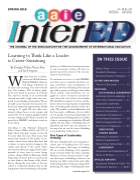SPRING 2018 Vol. 45 No. 125 InterED (Print) InterED (Online) ISSN 2158-0618 ISSN 2158-0626 InterED THE JOURNAL OF THE ASSOCIATION FOR THE ADVANCEmENT OF INTERNATIONAL EDUCATION Learning to ink Like a Leader is Career-Sustaining By Douglas Fisher, Nancy Frey Wand Ian Pumpian e have been the co-admin- istrators of Health Sciences High & Middle College, in San Diego, California, for 11 years and counting. Our school enrolls over 700 students, 80% of whom quali- fy for free lunch (a measure of poverty). e school is located in an economically stressed area with a high crime rate com- pared to surrounding communities. We are a health-career focused school and our stu- dents have internship opportunities weekly, starting in 9th grade. We also o er com- munity college classes on our campus and nearly 75% of our students graduate with 9 or more college credits. ere is much to be proud of at HSHMC and there is much to worry about. According to the National Education Policy Center (Fuller, 2012), only 27% of high school principals remain on the job for more than ve years. at means that nearly three-fourths of the leaders of sec- ondary schools leave before they have had a chance to create positive changes in the culture and climate of the school. Policy and research advocates suggest that it takes upwards of seven years to create lasting systems change (Fink & Brayman, 2006). Poignantly, we know that it is much faster to cause harm to the climate of the school. But to change the very nature of the way school is conducted, whether that be the integration of new technology, or discipline IN THIS ISSUE Editor's Desk ---------------------- 2 President's Message-------------- 4 Executive Director's Message --- 7 IN HER OWN WORDS Tribute to Elsa Lamb ----------- 13 FEATURES SUSTAINABLE LEADERSHIP Sustaining School Leadership- 15 Trust, Fear, Transformation---- 21 Sustainable Leadership from International School Director's Perspective ---------- 24 Standards of Excellence in School-Head Evaluations ------ 28 Teacher Engagement and the Pursuit of Happiness ------ 32 INNOVATIVE LEADER AWARD Meaningful Innovation --------- 36 Teacher Preparation for Home-School Partnerships ---- 38 LEADERSHIP Connections and Implications of Praise on Mindset--------------- 44 SPECIAL REPORTS Exceptional Children & Youth - 46 GIN News & Reports ------- 48-50 policies, or collaborative learning structures or new assessment systems, the time re- quired exceeds the tenure of the vast ma- jority of school leaders. To maintain our focus to lead HSHMC year after year, to maintain the drive, en- ergy, motivation, and commitments re- quired a new way of thinking. Several years ago, with a group of colleagues from other school systems and universities, we en- gaged in a series of exercises and discus- sions about the role of the school leader. We identi ed a number of actions and be- haviors but more importantly, we identi ed ways of thinking that e ective leaders de- velop. We needed to think di erently, and that has made a di erence. As we re ect on our decade of site-based leadership, we realized that the thinking habits of leaders is key to sustaining true leadership. We will explore the ve types of thinking that we identi ed and then turn our attention to the ways that we use this time of thinking in our leadership of the school. Five Types of Leadership Thinking We have identi ed ve non-mutually ex- clusive areas of thinking focus. Of course, they each impact other types of thinking. We see systems thinking as the organiza- tional tool that holds the others together. However, we have found it useful to sepa- rate these types of thinking so that we can develop our skills and provide each other with feedback that is humane and growth- producing. e types of thinking that have continued, page 8
